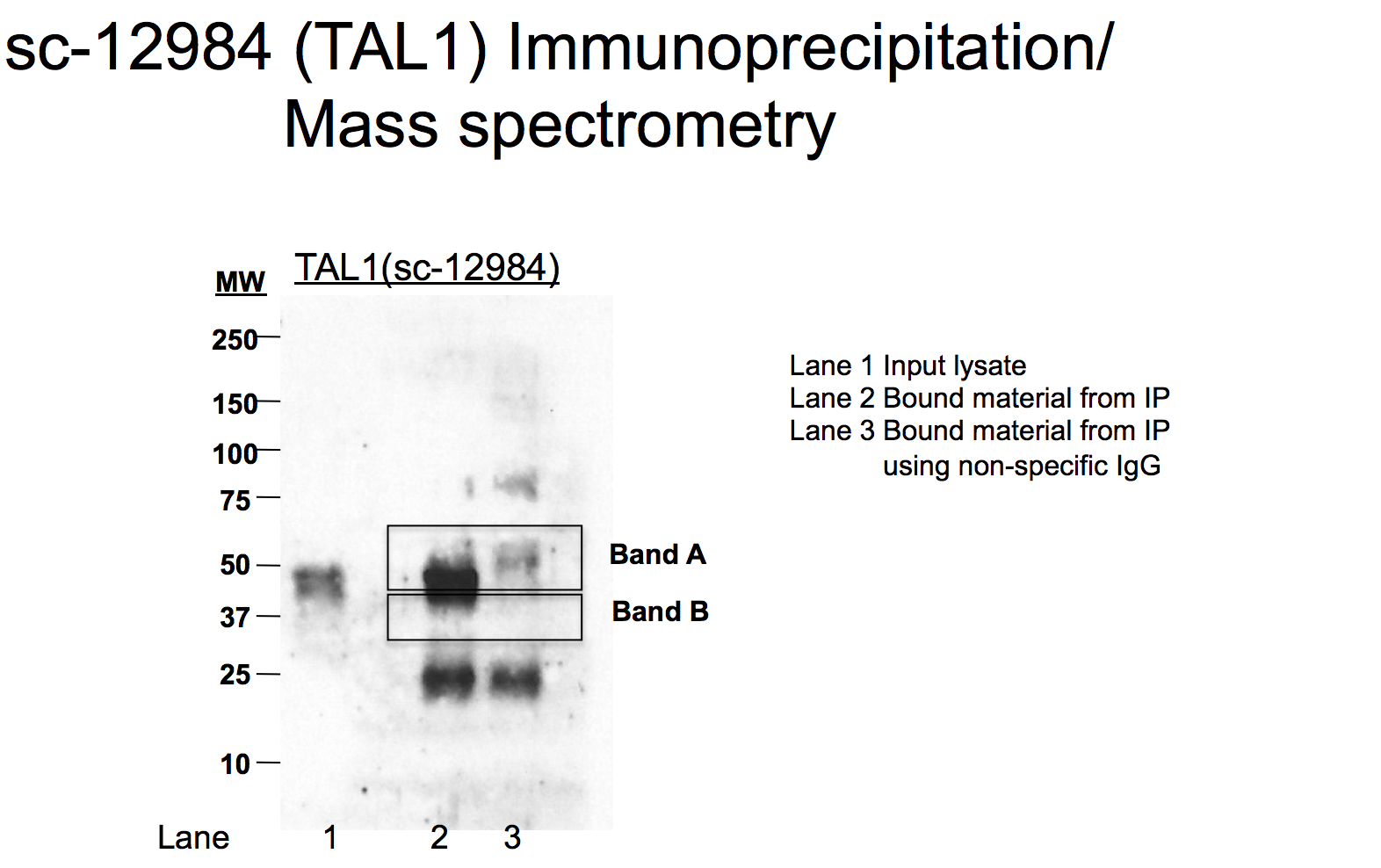ENCAB000ALO
Antibody against Homo sapiens TAL1, Mus musculus TAL1
Homo sapiens
at least one cell type or tissue, G1E, G1E-ER4, MEL, CH12.LX, K562
not characterized to standards
- Status
- released
- Source (vendor)
- Santa Cruz Biotech
- Product ID
- sc-12984
- Lot ID
- J2209
- Characterized targets
- TAL1 (Homo sapiens), TAL1 (Mus musculus)
- Lot ID aliases
- B2511
- Host
- goat
- Clonality
- polyclonal
- Purification
- affinity
- Antigen description
- Epitope mapping at the C-terminus of TAL1 of human origin.
- External resources
Characterizations
TAL1 (Homo sapiens)
Method: immunoprecipitation
not reviewed
- Caption
- A single major band is observed in K562 nuclear lysates. This band is efficiently and specifically immunoprecipitated. While this band migrates somewhat slower than expected (expected molecular weight of ~34kD), we note that this behavior has been reported (see product characterization literature for this antibody and others against TAL1 on manufacturer's website) and that the identity of this band was confirmed by mass spectrometry (see validation #2). Therefore, sc12984 meets this criterion for validation.
- Submitted by
- Michael Snyder
- Lab
- Michael Snyder, Stanford
- Grant
- U54HG004558
- Download
- human_TAL1_validation_Snyder.pdf
TAL1 (Homo sapiens)
Method: immunoprecipitation followed by mass spectrometry
not reviewed
- Submitted by
- Michael Snyder
- Lab
- Michael Snyder, Stanford
- Grant
- U54HG004558
- Download
- human_TAL1_validation_Snyder.pdf
TAL1 (Mus musculus)
G1EG1E-ER4MELCH12.LX
Method: immunoblot
compliant
- Submitted by
- Ross Hardison
- Lab
- Ross Hardison, PennState
- Grant
- RC2HG005573
- Download
- mouse_TAL1_validation_Hardison.pdf
TAL1 (Homo sapiens)
K562
not reviewed
- Caption
- Immunoprecipitation of TAL1 from K562 cells using sc12984. Lane 1: input nuclear lysate. Lane 2: material immunoprecipitated with ab87525. Lane 3: material immunoprecipitated using control IgG. Bands A and Be were excised from the gel and subject to analysis by mass spectrometry.
- Reviewer comment
- The review of this IP is dependent on the interpretation of resulting mass spec result since another TF was detected to be more enriched than TAL1.
- Submitted by
- Kathrina Onate
- Lab
- Michael Snyder, Stanford
- Grant
- U54HG004558
TAL1 (Homo sapiens)
Method: immunoprecipitation followed by mass spectrometry
not compliant
- Caption
- IP followed by mass spectrometry: Briefly, protein was immunoprecipitated from K562 whole cell lysates using sc12984, and the IP fraction was loaded on a 10% polyacrylamide gel (NuPAGE Bis-Tris Gel) and separated with an Invitrogen NuPAGE electrophoresis system. The gel was silver-stained, gel fragments corresponding to the bands indicated were excised and destained using the SilverSNAP Stain for Mass Spectrometry (Pierce). Then proteins were trysinized using the in-gel digestion method. Digested proteins were analyzed on an LTQ-Orbitrap (Thermo Scientific) by the nanoLC-ESI-MS/MS technique. Peptides were identified by the SEQUEST algorithm and filtered with a high confidence threshold (Protein false discovery rate < 1%, 2 peptides per protein minimum).
- Submitter comment
- Minyi Shi: I could not find any evidence of an interaction between ILF2 and TAL1
- Reviewer comment
- ILF2 (http://www.genecards.org/cgi-bin/carddisp.pl?gene=ILF2) is ranked higher than the target TF by enrichment, is ILF2 a known interacting partner of TAL1?
- Submitted by
- Kathrina Onate
- Lab
- Michael Snyder, Stanford
- Grant
- U54HG004558
- Download
- TAL1_final.pdf
